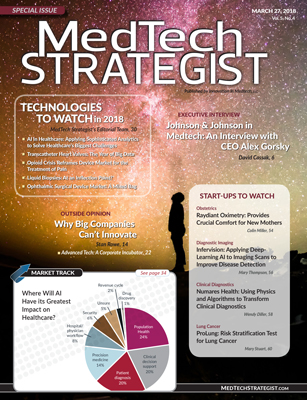MedTech Strategist Issue Vol. 5, No. 4 - March 27, 2018
Welcome NYCHBL Members, please download your complimentary PDF of the special issue of MedTech Strategist here.
Article Summaries Issue Vol. 5, No. 4 - March 27, 2018
Technologies to Watch in 2018, Part 1 - Liquid Biopsies: At an Inflection Point?
By Wendy Diller, Senior Writer/Market Analyst
Clinical diagnostics are ground zero for precision medicine initiatives, which are rapidly making their way into mainstream medicine, and within this field, nowhere is investor interest higher than in the scientifically burgeoning field of liquid biopsies. As the body of evidence grows, developments in 2018 could further clarify both the medical potential and likely commercial leaders in the space—although this understanding comes with caution, as evidenced by the just released ASCO/CAP joint review of the field.
Outside Opinion - Why Big Companies Can’t Innovate
By Stan Rowe
With their enormous resources and R&D spend, multinational medtech companies should be able to do amazing innovation, but too often they’re not. Here's why they aren't and what they can do to change that.
Technologies to Watch in 2018, Part 1 - AI in Healthcare: Applying Sophisticated Analytics to Solve Healthcare’s Biggest Challenges
By Mary Thompson, Mary Stuart, and Wendy Diller
Artificial intelligence is a catch-all phrase that runs the gamut of high-level computer capabilities, including deep-learning neural networks and predictive analytics, and it is receiving a lot of attention for its potential to transform the healthcare industry. But does the reality match the hype? Well, yes and no. AI has the potential to make healthcare faster, cheaper, and better, but it’s not a panacea. The applications and executions may be new, but in the end, the goals remain the same.
Technologies to Watch in 2018, Part 1 - Transcatheter Heart Valves: The Year of Big Data
By Stephen Levin, Co-Editor-in-Chief
The exciting news in heart valves centers around clinical trial data, rather than new technologies. Several major studies are expected to be announced this year, which could confirm the value of transcatheter devices compared with existing medical therapy.
Technologies to Watch 2018, Part 1 - Opioid Crisis Reframes Device Market for the Treatment of Pain
By Mary Stuart, Senior Writer/Market Analyst
The opioid crisis has created heightened awareness, amongst physicians and patients, of the need to find alternatives to drugs for the treatment of chronic pain, and much of the focus in the medtech world is on neurostimulation devices. This is happening just as device companies are garnering a new understanding of mechanisms of action to improve spinal cord stimulation, and also are incorporating digital health tools to create more objective bodies of data on the efficacy of such approaches.
Johnson & Johnson in Medtech: An Interview with CEO Alex Gorsky
By David Cassak, Co-Editor-in-Chief
Over the past half-decade, no life science company has achieved the growth in shareholder value that Johnson & Johnson has. Much of that, however, has come from a reinvigorated pharmaceutical business. As change and headwinds confront the medical device industry, J&J CEO Alex Gorsky talks about J&J’s medtech businesses and where they fit in the company’s portfolio.
Technologies to Watch in 2018, Part 1 - Ophthalmic Surgical Device Market: A Mixed Bag
By Michael Lachman
Micro-invasive glaucoma surgery (MIGS) is the stand-out performer in the ophthalmic surgical device market at the moment, leading the way both in terms of innovation and growth, while other segments are experiencing more incremental progress, hampered by cost-benefit concerns, a dearth of truly innovative new product solutions, and, in the case of corneal inlays, the many challenges associated with creating a new market.
Start-Ups To Watch - Raydiant Oximetry: Provides Crucial Comfort for New Mothers
By Colin Miller
After 50 years with limited advancements in monitoring for fetal well-being during labor, Raydiant Oximetry is developing a safe, non-invasive, completely external sensor that reports fetal blood oxygen levels. The information will provide clinicians the means to improve our understanding about how the fetus tolerates labor, and better inform decision-making for cesarean delivery.
Start-Ups to Watch - Infervision: Applying Deep-Learning AI to Imaging Scans to Improve Disease Detection
By Mary Thompson, Executive Editor
Chinese start-up Infervision is applying its deep-learning neural network technology to a variety of challenges in diagnostic imaging. The goals: to relieve radiologists of tedious tasks, improve efficiency, and reduce missed diagnoses.
Start-Ups to Watch - Numares Health: Using Physics and Algorithms to Transform Clinical Diagnostics
By Wendy Diller, Senior Writer/Market Analyst
Metabolomics, the study of complex relationships of metabolites within physiological systems, defies clinical diagnostic analysis by traditional tools, but a combination of nuclear magnetic resonance and machine learning is up to the challenge.
Start-Ups to Watch - ProLung: Risk Stratification Test for Lung Cancer Increases Physician Confidence, Lowers Costs, and Speeds up Diagnosis
By Mary Stuart, Senior Writer/Market Analyst
Patients with lung cancer are not well served by the current diagnostic model, which often puts them through months of years of anxious “watchful waiting” in the form of repeated imaging and diagnostic exams before the definitive but risky step of lung biopsy. ProLung hopes to change this paradigm with a front-end predictive analytic that’s adjunctive to the first low-dose computed tomography screen.













